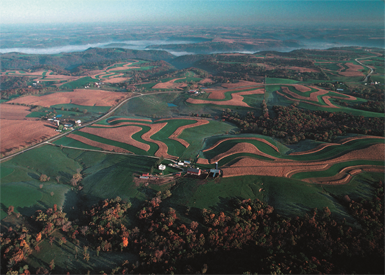Healthy Lands, Healthy Waters
posted
on Wednesday, January 6, 2016
Note: This article is the first in a series of upcoming blog posts about the importance of a watershed approach for Iowa, the focus of a new white paper released today by the Iowa Environmental Council. This entry summarizes the main themes in the white paper. Follow-up articles, which will be posted each week in January as part of our Watershed Wednesday series, will highlight efforts that illustrate many of these themes. Cleaning up our water is possible, and if we have the will, vision and resources to work together in a coordinated, collaborative way, we can achieve success.
 |
| Conservation practices, like the buffer strips pictured here, improve water quality and soil health. Photo credit: NRCS |
Conversations about water quality are taking place across Iowa. While each discussion takes its own form and focus, virtually all of them reflect a desire for clean water and healthy land.
“The issues are diverse and affect rural, urban and natural areas across the state. Recent events, as well as long-standing issues, are making it clear that current water quality efforts are not making progress at the pace and scale needed for meaningful change,” said Agricultural Policy Specialist Ann Robinson. “High levels of nitrates in drinking water, record-breaking beach closures, and an uptick in Iowa’s impaired waters are just some of the problems that plague Iowa’s lakes, rivers and streams.”
The state has introduced several plans and programs to address these challenges, including the Iowa Nonpoint Source Management Plan, the Iowa Nutrient Reduction Strategy, and Watershed Management Authorities. If Iowa wants to move the needle on improving water quality, it must knit these plans together under a collaborative strategy that is coordinated, accountable and funded.
The Iowa Environmental Council is one of the key players driving this conversation. Today we released Healthy Lands, Healthy Waters: A Watershed Framework, a white paper that lays out the need for and benefits of adopting a watershed approach in Iowa.
“Like a comprehensive health plan with individual components targeted to address specific concerns and improve overall health, a watershed framework should be holistic,” said Robinson. “Prescriptions for individual actions should be integrated to consider the watershed’s water and soil conservation status, flooding issues and related concerns like public health and recreation.”
Such an approach would not abandon existing plans and projects. Rather, it would bring them together under one umbrella to leverage limited resources and maximize impacts.
“This is not a new idea,” said Water Program Director Susan Heathcote. “In 2008, the Iowa Legislature authorized a statewide watershed assessment program following recommendations from the 2007 Watershed Planning Task Force. The Iowa Nonpoint Source Management Plan, developed in 2012, and the Iowa Nutrient Reduction Strategy released in 2013, contain elements of a watershed framework, but have not been fully implemented due to lack of funding. The blueprint is there. Now is the time to act, and Iowa’s Water Resources Coordinating Council, created per recommendations from the 2007 Iowa Watershed Planning Task Force, has the authority to lead this effort.”
Much of the sustained funding needed to implement an Iowa watershed framework could come from Iowa’s Natural Resource and Outdoor Recreation Trust Fund. Created by an overwhelming majority of Iowa voters in 2010, the Trust would provide an estimated $120 million or more per year once the state sales tax is raised by 3/8ths of a cent. The opportunity to fund the Trust will come before the Legislature again in the 2016 session. Other states, including Minnesota, have similar tax-supported funds for water quality that have received widespread support.
The need for a watershed framework is clear, the foundation has been set, and existing Iowa plans and programs are well-suited to fit within it – we need only seize the opportunities. Together, we can be the agents of change our lakes, rivers and streams so desperately need.
You can download a copy of the Council's white paper, Healthy Lands, Healthy Waters as a PDF, or request a hard copy from Ann at Robinson@iaenvironment.org or 515-244-1194, ext. 211.
- conservation
- healthy soil
- water quality
- watershed wednesday